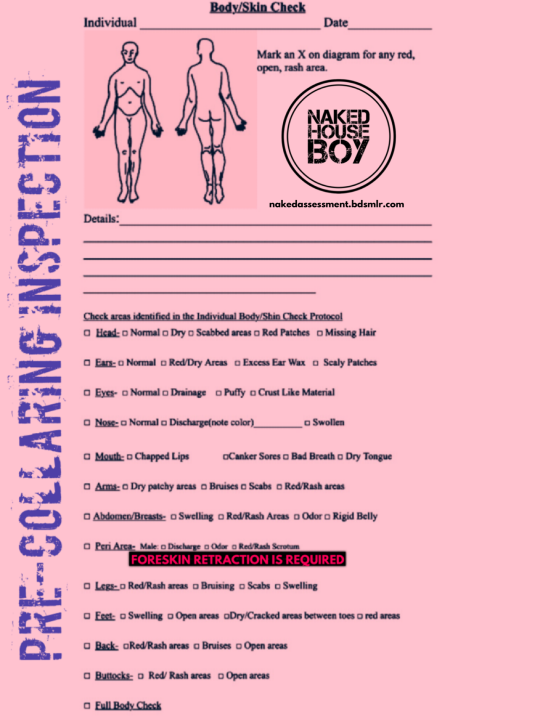Assessment and Screening —
Body and Skin Check Sheet

Every prospective House Boy will be furnished a copy of the Body and Skin Check Sheet at or before his Pre-Collaring Interview. The Master will discuss the contents of the form with the candidate, explaining to him that a secondary hands-on examination of one or up to a dozen or more specific body areas may be conducted at the Pre-Collaring Inspection. Applicants will be permitted to ask questions and discuss any areas of concern. Appropriate Terminology must be used since the Interview takes place at a public location where a conversation may be accidentally overheard or contents of the Body and Skin Check Sheet could be unintentionally viewed by passers-by. Candidates must date and sign or initial the Body and Skin Check Sheet to indicate their consent to examination under the terms of this rule.
The 12 specific body areas which are most commonly flagged for secondary examination are the applicant’s head, ears, eyes, nose, mouth, arms, abdomen-chest, genitals, legs, feet, back, and buttocks. Very few applicants will be secondarily examined in all 12 areas, but most applicants are flagged for secondary examination in one or more areas. The primary difference between the Strip Search Inspection and the Body and Skin Examination is that the former is primarily a checklist for visual examination and the latter is a hands-on secondary and more detailed examination which may require that the skin or body part be physically examined or tested for tendon reflex, temperature sensitivity, allergen response, pressure testing, discharge, etc.
Some examples of typical secondary examinations are as follows:
- Kneecap, which may be tapped with a rubber hammer or similar tool to determine if the reactive kick is within norms
- Scrotum, which may be gently exposed to a cloth-covered ice pack or application of cold water to evaluate epidermal response and shrinkage, or soaked in warm water or exposed to heated air to determine whether the skin sags and the testicles hang evenly and low
- Pubic bone, which may be sensitive to shaving or hair removal products and may be tested with small amounts of product to determine susceptibility to rash, red bumps, or other anomalies
- Nostrils, which may be briefly pressed closed with a fingertip one at a time to determine if the opposing nostril is capable of filling and emptying the lungs
- Perenium, which may need to be manipulated or gently dusted to evaluate type and volume of penile discharge if such has been observed or suspected
Applicants who are flagged for secondary Body and Skin Examination and who are determined to have unresolved issues will not necessarily be disqualified from consideration, but the issue will be noted for monitoring and follow-up whenever possible. The candidate may be advised to seek medical attention since the Master is not a medical professional and the Body and Skin Check is not intended to be a medical examination or evaluation. The purpose of the Body and Skin Check is for the Master to determine his own comfort level and the candidate’s compatibility with the inspection and examination process, and to allow the applicant to learn and become comfortable with the inspection and examination protocols which will be adhered to after collaring.
If two or more applicants are present for simultaneous or overlapping Pre-Collaring Inspections, the Master reserves the right to assign applicants to assist in examining each other to save time. All inspections or examinations will be supervised by the Master at all times. Any applicant who is found to need a secondary examination of any body part or area not listed on the form is subject to a Full Body Secondary Inspection, which will be so noted on the bottom line of the chart along with any negative issues if found.